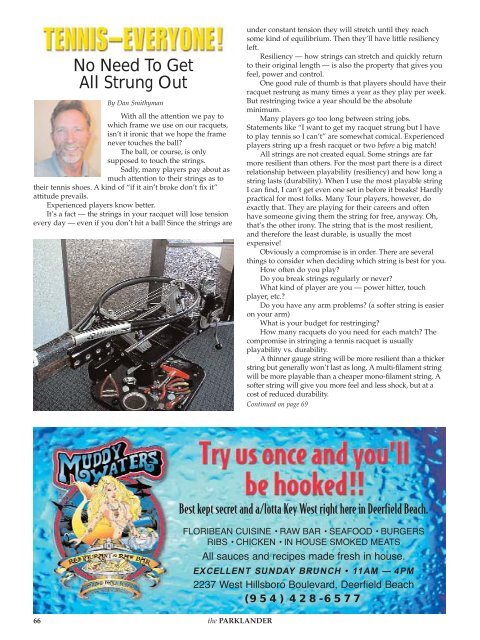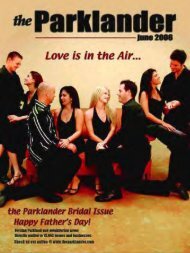Cover_Jan 05 (Page 2) - The Parklander Magazine
Cover_Jan 05 (Page 2) - The Parklander Magazine
Cover_Jan 05 (Page 2) - The Parklander Magazine
- No tags were found...
Create successful ePaper yourself
Turn your PDF publications into a flip-book with our unique Google optimized e-Paper software.
No Need To Get<br />
All Strung Out<br />
By Dan Smithyman<br />
With all the attention we pay to<br />
which frame we use on our racquets,<br />
isn’t it ironic that we hope the frame<br />
never touches the ball<br />
<strong>The</strong> ball, or course, is only<br />
supposed to touch the strings.<br />
Sadly, many players pay about as<br />
much attention to their strings as to<br />
their tennis shoes. A kind of “if it ain’t broke don’t fix it”<br />
attitude prevails.<br />
Experienced players know better.<br />
It’s a fact — the strings in your racquet will lose tension<br />
every day — even if you don’t hit a ball! Since the strings are<br />
under constant tension they will stretch until they reach<br />
some kind of equilibrium. <strong>The</strong>n they’ll have little resiliency<br />
left.<br />
Resiliency — how strings can stretch and quickly return<br />
to their original length — is also the property that gives you<br />
feel, power and control.<br />
One good rule of thumb is that players should have their<br />
racquet restrung as many times a year as they play per week.<br />
But restringing twice a year should be the absolute<br />
minimum.<br />
Many players go too long between string jobs.<br />
Statements like “I want to get my racquet strung but I have<br />
to play tennis so I can’t” are somewhat comical. Experienced<br />
players string up a fresh racquet or two before a big match!<br />
All strings are not created equal. Some strings are far<br />
more resilient than others. For the most part there is a direct<br />
relationship between playability (resiliency) and how long a<br />
string lasts (durability). When I use the most playable string<br />
I can find, I can’t get even one set in before it breaks! Hardly<br />
practical for most folks. Many Tour players, however, do<br />
exactly that. <strong>The</strong>y are playing for their careers and often<br />
have someone giving them the string for free, anyway. Oh,<br />
that’s the other irony. <strong>The</strong> string that is the most resilient,<br />
and therefore the least durable, is usually the most<br />
expensive!<br />
Obviously a compromise is in order. <strong>The</strong>re are several<br />
things to consider when deciding which string is best for you.<br />
How often do you play<br />
Do you break strings regularly or never<br />
What kind of player are you — power hitter, touch<br />
player, etc.<br />
Do you have any arm problems (a softer string is easier<br />
on your arm)<br />
What is your budget for restringing<br />
How many racquets do you need for each match <strong>The</strong><br />
compromise in stringing a tennis racquet is usually<br />
playability vs. durability.<br />
A thinner gauge string will be more resilient than a thicker<br />
string but generally won’t last as long. A multi-filament string<br />
will be more playable than a cheaper mono-filament string. A<br />
softer string will give you more feel and less shock, but at a<br />
cost of reduced durability.<br />
Continued on page 69<br />
Best kept secret and a/lotta Key West right here in Deerfield Beach.<br />
FLORIBEAN CUISINE • RAW BAR • SEAFOOD • BURGERS<br />
RIBS • CHICKEN • IN HOUSE SMOKED MEATS<br />
All sauces and recipes made fresh in house.<br />
EXCELLENT SUNDAY BRUNCH • 11AM — 4PM<br />
2237 West Hillsboro Boulevard, Deerfield Beach<br />
(954) 428-6577<br />
66<br />
the PARKLANDER
















